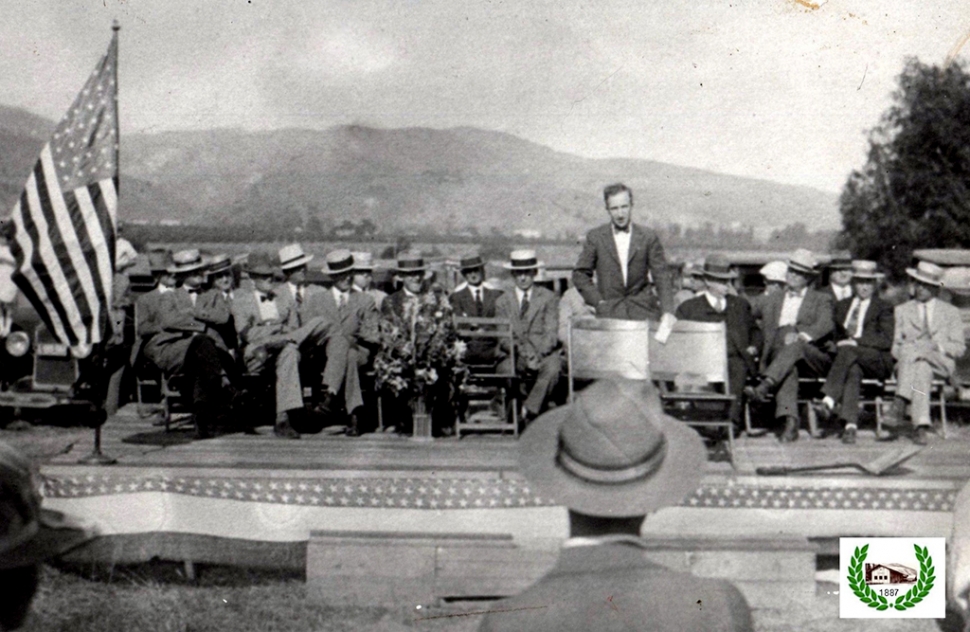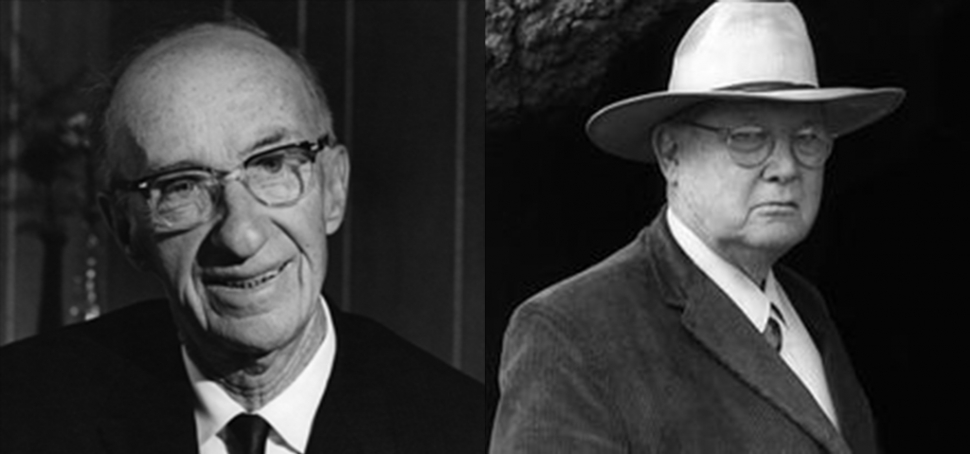|
The Story of John Galvin
 John Galvin speaking at Monorail Groundbreaking in 1927. Photos courtesy Fillmore Historical Museum. By Gazette Staff Writers — Wednesday, October 13th, 2021
 (l-r) John Galvin in 1961, Erle Stanley Gardner in 1966. Courtesy Fillmore Historical Museum We say Fillmore was founded in 1887 when the railroad came through, but it was not an actual town until 1914 when it was incorporated. Incorporation was not an assured event. There was strong opposition, mainly on the basis that creating a city would put another layer of taxes on the locals. On the other side was the argument that taxes currently being paid weren’t coming back to the local residents but being spent elsewhere in the county. Streets were not paved and the only paved sidewalks were those put in by the adjacent business owner. In August of 1914 the election was held with the vote split 208 for incorporation and 193 against. Fillmore became the newest city in Ventura County. In the same election George Tighe, the first station master and store owner, was elected mayor and Clarence Arrasmith was elected city clerk. Besides Tighe on the “board of trustees”, forerunner to the city council, were Bowman Merrill, druggist; E. O. Goodenough, merchant; E. A. Pyle, “financier”; and S. H. Mosher, hardware merchant. At the first trustee meeting two additional officials were appointed – John Galvin as city attorney and Jack Casner, city marshal, both would receive the salary of $25 per month. Two of the new city officials would serve Fillmore well into the second half of the twentieth century – Clarence Arrasmith and John Galvin. John Galvin was born in Kentucky in 1888, but grew up in Rawlins, Wyoming, where he graduated from high school. He then went to the University of Michigan Law School, graduating in 1910. Immediately on graduation he moved to California, originally settling in Oxnard but finding no legal work there got a job at the sugar beet factory. A chance meeting with C. C. Elkins brought him to Fillmore in 1911. In 1913, other family members from Rawlins moved to Fillmore. His father, Warren, was employed as a bookkeeper at the refinery. His brother, Warren, served in World War One, then worked as an electrician before serving in various law enforcement positions. His sister, Leona, worked in the post office for many years and was active in the Soroptimists. Sister Mary graduated from Fillmore High school in 1919 and worked for several years at United Mercantile before graduating from the USC School of Music and having a career teaching in El Rio and the Briggs School district before coming to Fillmore school in 1942. Mary was the beloved kindergarten teacher to several generations of the children of our community. Youngest sister, Katherine, graduated from Fillmore High school in 1923 and married William Grady who also worked for the Post Office. Mary and Katherine were both accomplished musicians and entertained at Clarence Arrasmith’s “Happy Hours.” When asked how he was chosen with little experience to be city attorney, he replied, “It happened I was in the right place at the right time to draw up the incorporation papers and become the attorney. I had personality, obvious and unimpeachable character and I was the only attorney in town.” (Fergus Fairbanks was working as clerk at the Fillmore State Bank but hadn’t finished law school yet). In July, 1920, he married Elizabeth Grenier, who was a teacher at Fillmore Union High School. City Attorney was not a full-time job. John Galvin had a busy practice handling both civil and criminal cases. In addition to his legal work, he was active in community and county activities. As a public speaker he was also in demand. The May 3rd, 1934, Piru News reported that “Aside from the fact that Johnny Galvin is one of the most capable lawyers in Ventura County, he also finds time to go to the smaller communities and give them the benefit of his findings on what constitutes good citizenship. . . Not only his unquestioned ability but his wholesome manner and pleasing personality always assure him a warm welcome in Piru.” He was also active in the Rotary, serving as president in 1926. He was also a member of the Fillmore Club. In 1933, he became the president of the Ventura County Bar Association upon the resignation of one Earl Gardner, aka Erle Stanley Gardner the creator of Perry Mason. Like Galvin, Gardner had been admitted to the California Bar in 1911 and he first practiced in Merced until 1917. Through the years the two men came to know and respect each other. In May of 1950 Edith Moore Jarrett wrote to Gardner for advice on the contract Houghton Mifflin had sent her for her text book, “El Camino Real.” While Gardner explained he had not practiced law for several years and so could not give her advice on the contract he did suggest several places that could help her. He ended his letter to her with “…. it is a pleasure to do anything I can for anyone who is a friend of John Galvin’s.” John Galvin retired for the position of City Attorney in 1964 and was honored by both the City of Fillmore and the League of California Cities recognizing his long years of service. He passed away in 1966. |
